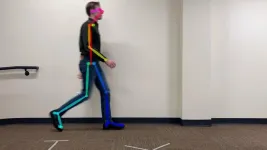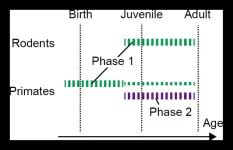(Press-News.org) Automated external defibrillators (AEDs) are a common resource in public buildings, yet a new analysis reveals that they are rarely used to help resuscitate people suffering cardiac arrest. Research, which will be presented at the American College of Cardiology’s Annual Scientific Session, found that AEDs were only used in 13 of nearly 1,800 cases of out-of-hospital cardiac arrest, even though many of the incidents occurred near a public AED.
Cardiac arrest occurs when the heart suddenly stops beating. It is different from a heart attack, which is when a blockage prevents blood from reaching the heart. Cardiac arrests often happen without warning, causing a person to collapse and become unresponsive. Cardiac arrests outside of a hospital setting are usually fatal but administering cardiopulmonary resuscitation (CPR) and using an AED greatly increases the chances of survival.
AEDs—devices that analyze the heart rhythm and deliver an electric shock if necessary—are designed to be easy for untrained bystanders to use, and many states have laws requiring these devices to be available in public places, such as airports, shopping malls, schools and gyms.
“Public AED availability is critical for people to be able to use them in the appropriate time and fashion,” said Mirza S. Khan, MD, a physician and medical informatician at the University of Missouri-Kansas City and the study’s lead author. “However, people need to know it’s there to be able to use it. It’s not sufficient just to have them in the right places.”
The study used data from a national registry to analyze 1,799 cardiac arrests that occurred at home or in public settings in Kansas City, Missouri between 2019-2022. Researchers calculated walking times from where each cardiac arrest occurred to the nearest registered AED using a database of public AEDs in the city.
According to the results, a vast majority (about 85%) of the cardiac arrests occurred at home. A bystander (someone other than a paramedic) administered CPR in 42% of these cases but AEDs were never used. Researchers calculated that nearly one-quarter of at-home cardiac arrests occurred within a four-minute walk of a public AED.
Among cardiac arrests that occurred in public, a bystander administered CPR in about 42% of cases and used an AED in about 7% of cases. Nearly half of these cardiac arrests occurred within a four-minute walk of an AED. Even in the “optimal scenario” in which a bystander administered CPR and the event occurred within a four-minute walk of an AED (the “optimal” scenario), an AED was used in only about 1 out of 4 cases.
Taken together, the results suggest that AEDs are often available but underutilized. By drawing attention to this gap, the findings could help inform ongoing efforts to improve signage around AEDs, provide apps or mapping tools to help people locate them and increase education and awareness through community volunteer training programs.
“It’s been heartening to see the enthusiasm from local governments and organizations, who are really keen to use this work to help build up to that next level of narrowing that gap in terms of the AED usage that we’d like to see,” Khan said.
According to the U.S. Centers for Disease Control and Prevention, over 356,000 out-of-hospital cardiac arrests occur in the U.S. each year—an average of more than 1,000 each day. It is estimated that only about 10% of people who suffer an out-of-hospital cardiac arrest survive. Signs of cardiac arrest include sudden collapse and loss of consciousness, being unresponsive to shouting or shaking, gasping for air or not breathing and lack of a pulse. If you believe someone is having a cardiac arrest, you should call 911 right away, look for an AED and give CPR until medical professionals arrive.
This study was funded by the National Heart, Lung, and Blood Institute, a division of the National Institutes of Health.
To learn more about sudden cardiac arrest, visit CardioSmart.org/Topics/Sudden-Cardiac-Arrest.
Advocating for CPR education and AEDs is a key health policy priority for the ACC at the state and national level. ACC is a member of the NFL-led Smart Heart Sports Coalition, which advocates for all 50 states to adopt evidence-based policies that will prevent fatal outcomes from sudden cardiac arrest among high school students.
Khan will present the study, “Walking Time to Closest Public Automated External Defibrillator for Out-of-Hospital Cardiac Arrest in a Major City,” on Saturday, April 6, 2024, at 11:45 a.m. ET / 15:45 UTC in Hall B4-5.
ACC.24 will take place April 6-8, 2024, in Atlanta, bringing together cardiologists and cardiovascular specialists from around the world to share the newest discoveries in treatment and prevention. Follow @ACCinTouch, @ACCMediaCenter and #ACC24 for the latest news from the meeting.
The American College of Cardiology (ACC) is the global leader in transforming cardiovascular care and improving heart health for all. As the preeminent source of professional medical education for the entire cardiovascular care team since 1949, ACC credentials cardiovascular professionals in over 140 countries who meet stringent qualifications and leads in the formation of health policy, standards and guidelines. Through its world-renowned family of JACC Journals, NCDR registries, ACC Accreditation Services, global network of Member Sections, CardioSmart patient resources and more, the College is committed to ensuring a world where science, knowledge and innovation optimize patient care and outcomes. Learn more at ACC.org.
###
END
Whether you like your eggs sunny-side up, hard boiled or scrambled, many hesitate to eat them amid concerns that eggs may raise cholesterol levels and be bad for heart health. However, results from a prospective, controlled trial presented at the American College of Cardiology’s Annual Scientific Session show that over a four-month period cholesterol levels were similar among people who ate fortified eggs most days of the week compared with those who didn’t eat eggs.
A total of 140 patients with or at high risk for cardiovascular disease were enrolled in ...
Young to middle-aged women who reported drinking eight or more alcoholic beverages per week—more than one per day, on average—were significantly more likely to develop coronary heart disease compared with those who drank less, finds a study presented at the American College of Cardiology’s Annual Scientific Session. The risk was highest among both men and women who reported heavy episodic drinking, or “binge” drinking, and the link between alcohol and heart disease appears to be especially strong among women, according to the findings.
The study focused on 18- to 65-year-old ...
The Texas Tech University Health Sciences Center (TTUHSC) School of Nursing announced March 27 the establishment of the TTUHSC Center for Nursing Research, Collaboration and Innovation.
“Interprofessional collaboration is essential for advancing research in health care,” TTUHSC School of Nursing Dean and Professor Holly Wei, Ph.D., said. “By bringing together professionals from various disciplines, we can harness a wide range of perspectives and skills to develop innovative solutions that significantly impact patient care and outcomes.”
For years, the TTUHSC School of Nursing has been recognized for its ability to educate ...
How much fuel can we add to the fire while still maintaining control?
Metaphorically speaking, that’s the question one team at the U.S. Department of Energy’s Princeton Plasma Physics Laboratory (PPPL) has been asking themselves lately.
Now, they believe they have the answer for one particular scenario. It’s all a part of the Lab’s work to bring energy from fusion to the power grid.
Building upon recent findings showing the promise of coating the inner surface of the vessel containing a fusion plasma in liquid lithium, the researchers have determined the maximum density of uncharged, or neutral, particles at the edge of a plasma before the edge ...
A healthy gut plays an indispensable role in the absorption and metabolism of nutrients, maintaining immune function, and promoting general well-being. The profound impact of a healthy microbiome is not just limited to the gut, but there is mounting evidence that it influences almost every function of the body. Thus, the composition of the gut microbiome becomes an important indicator of health status of the body.
Probiotics are a type of supplements containing live strains of bacteria that improve and diversify the gut microbiome population. Lactiplantibacillus plantarum, a type of microorganism ...
In many chemical-related industries, such as pharmaceuticals, oil refineries, and food and beverage factories, separating organic liquid mixtures is an essential step. A staple method to achieve this is distillation, which involves heating a mixture to a specific temperature so that only one of its components vaporizes. Though widely used, distillation fails to separate organic liquid mixtures in which both components have the same boiling point. Moreover, it’s an energy- and resource-intensive process, ...
BALTIMORE, March 27, 2024— Researchers at Kennedy Krieger Institute and Johns Hopkins Medicine have developed a new, accessible approach to analyze a patient’s walking ability and stances more effectively. Following numerous tests, they determined that a simple video recorded on a personal pocket device, such as a smartphone or tablet, can be used to measure gait at a clinical, high-quality level.
Experts say current state-of-the-art approaches to gait analysis are often expensive and inaccessible due ...
A new study led by Michigan State University researcher Peter Williams sheds light on the profound influence of deep geographic isolation on the evolution of mammals. Published in Nature Communications on March 28, the research reveals how long-lasting separation between continents has shaped distinct mammal communities around the globe.
“Today’s ecology was not inevitable. If there were different isolating factors long ago, we might have vastly different ecosystems today,” said Peter Williams, the lead author of the study. Williams is a research ...
The first analysis of how synaptic proteins change during early development reveals differences between mice and marmosets but also what's different in individuals with autism spectrum disorders. The Kobe University findings offer first insights into the mechanism behind synaptic development and open up routes for research on possible treatments.
Given that synapses are the connections between our brain cells, one might think that having as many of these as possible is a good thing. However, primate brains do something unexpected: After early childhood, ...
Lower-income communities across the United States have long been much slower to adopt solar power than their affluent neighbors, even when local and federal agencies offer tax breaks and other financial incentives.
But, commercial and industrial rooftops, such as those atop retail buildings and factories, offer a big opportunity to reduce what researchers call the “solar equity gap,” according to a new study, published in Nature Energy and led by researchers at Stanford University.
“The ...






